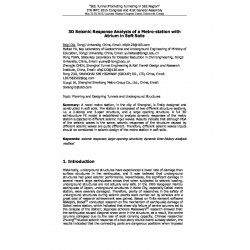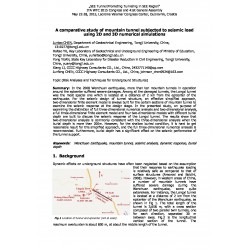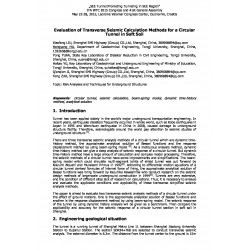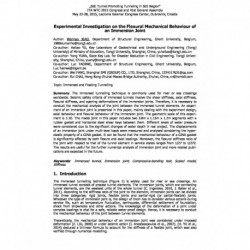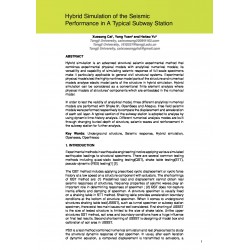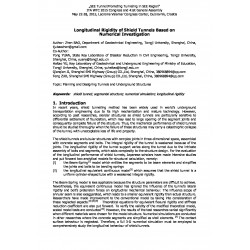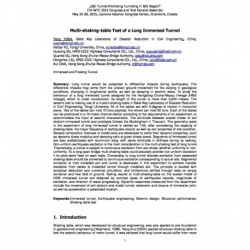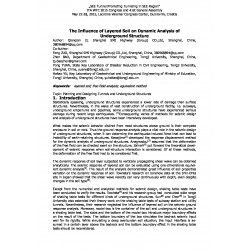No document
Search & filter
Search for a publication
Search & filter
List of products by author: H. Yu
-
3D Seismic Response Analysis of a Metro-station with Atrium in Soft Soils
Abstract: A novel metro station, in the city of Shanghai, is firstly designed and constructed in soft soils. The station is composed of two different structure sections, i.e. a 2-storey and 3-span structure, and a large opening structure. A full 3D soil-structure FE model is established to analyze dynamic responses of the metro station subjected to different seismic input waves. Results indicate that...
0,00 € -
A comparative study of mountain tunnel subjected to seismic load using 2D and 3D numerical simulations
Abstract: In the 2008 Wenchuan earthquake, more than ten mountain tunnels in operation around the epicenter suffered severe damages. Among all the damaged tunnels, the Longxi tunnel was the most special one which is located at a distance of 2 km from the epicenter of the earthquake. For the seismic design of tunnel structure, an effective simplified approach, two-dimensional finite element model is...
0,00 € -
Applying machine learning for ground type detection using monitored earth pressure
Abstract: Geological uncertainty poses significant risk for soft ground tunnelling. The current ground mapping relies on a few boreholes to estimate the geology along the tunnel alignment via either expert judgment or geostatistical modelling, which is inevitably uncertain due to borehole sparsity. As earth pressure balance tunnel boring machine (EPBM) behaviour changes in various grounds and are...
0,00 € -
Evaluation of Transverse Seismic Calculation Methods for a Circular Tunnel in Soft Soil
Abstract: Tunnel has been applied widely in the world's major underground transportation engineering. In recent years, earthquake disasters frequently occurred in whole world, such as Kobe earthquake in Japan in 1995 and Wenchuan earthquake in China in 2008, caused damage to underground structure facility. Therefore, seismologists around the world pay attention to seismic studies of underground...
0,00 € -
Experimental Investigation on the Flexural Mechanical Behaviour of an Immersion Joint
Abstract: The immersed tunnelling technique (Figure 1) is widely used for river or sea crossings. An immersed tunnel consists of precast tunnel elements. The immersion joints, which are connecting tunnel elements, are the weakest units of the whole tunnel (C. Ingerslev, 2010, J. Baber et al., 2011). According to the stiffness ratio of the joint to the element, immersion joints can be divided into three...
0,00 € -
Hybrid Simulation of the Seismic Performance in A Typical Subway Station
Abstract: Hybrid simulation is an advanced structural seismic experimental method that combines experimental physical models with analytical numerical models; its versatility and capability of simulating seismic response of full-scale specimens make it particularly applicable to general civil structural systems. Experimental physical models test the highly nonlinear model parts of the structure and...
0,00 € -
Longitudinal Rigidity of Shield Tunnels Based on Numerical Investigation
Abstract: In recent years, shield tunnelling method has been widely used in world’s underground transportation engineering due to its high mechanization and mature technology. However, according to past researches, slender structures as shield tunnels are particularly sensitive to differential settlement of foundation, which may lead to large opening of the segment joints and consequently complete...
0,00 € -
Multi-shaking-table Test of a Long Immersed Tunnel
Abstract: Shaking table, which was developed for structural engineering, was also applied to pile foundation in geotechnical engineering ( Meymand, 1998). Yang et.al (2004) applied structural shaking table to test the seismic behaviour of metro tunnel. It was believed that long tunnel would suffer from more
0,00 € -
The Influence of Layered Soil on Dynamic Analysis of Underground Structure
Abstract: Statistically speaking, underground structures experienced a lower rate of damage than surface structures. Nevertheless, in the wake of vast construction of underground facility, i.e. subways, underground emporiums and pipelines, some underground structures have experienced serious damage during recent large earthquakes. Consequently, varies of methods for seismic design and analysis of...
0,00 € -
Tunnel Process Control for Klang Valley Metro Phase 2 Using Machine Learning and Artificial Intelligence
Abstract: The Klang Valley Mass Railway Transit in Kuala Lumpur is mid-way through line 2 construction. The line faces several challenges including mixed face conditions, variable ground water and geologic hazards with high potential for large settlements and sink holes. Consequently, the influences on tunnel processes such as advance rates and cutter tool wear are hard to estimate. This paper presents...
0,00 €

